Anatomy of a Tapestry: Techniques, Materials, Care
Jean Pierre Larochette and Yadin Larochette along with Yael Lurie (illustrations) have produced a wonderful new book about tapestry. I read the whole thing this weekend and I highly recommend it. In fact, if you are a practicing tapestry weaver interested in French tapestry techniques, this book is an important one and absolutely should have a place on your shelf.
It contains information from a fairly wide swath of tapestry practice. Jean Pierre Larochette is an Aubusson-trained tapestry weaver with 60 or more years of experience who brings his practice to light quite poetically in this beautiful book. His daughter, Yadin Larochette, is not only a skilled tapestry weaver herself, having learned in her family’s workshop, but is also a textile conservator and provides a wealth of information in the last half of the book to help tapestry weavers create long-lasting textiles.
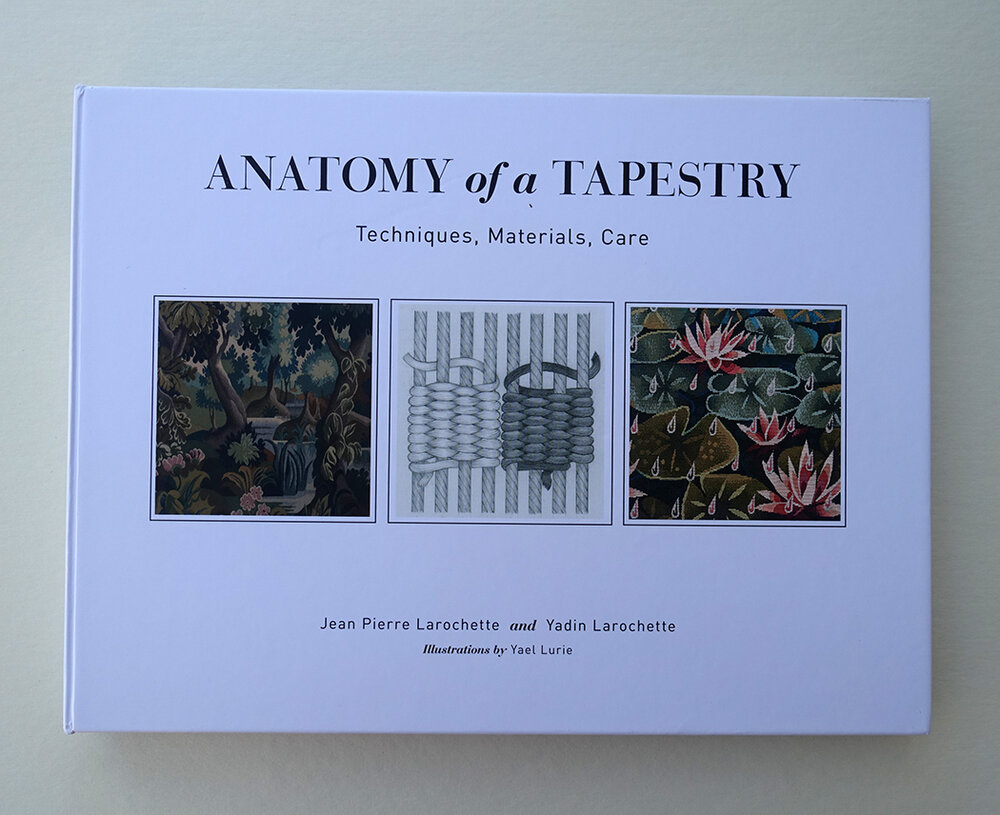
Anatomy of a Tapestry by Jean Pierre Larochette and Yadin Larochette
Lightness, flexibility, strength, and endurance, combined with a vast potential for artistic expression, have made tapestry a highly regarded cultural achievement.
Content
The book is laid out in a way that makes a lot of sense to me. It starts with a brief look at tapestry history. As this book is largely focused on French tapestry traditions, this focuses primarily on that. It should be noted that further on in the book, the authors mention other traditions in the context of tapestry weavers from other parts of the world and looms used in those traditions.
Then the content moves to more specifics about tapestry including the nature of the cloth of tapestry (it is durable for example and why that matters in the history of the medium) and weaving from the back and sideways as is traditional in Aubusson tapestry.
There is a generous section of tapestry techniques. These are very well illustrated and described in text. It should be noted that this book is not a beginning tapestry techniques text. You won’t find specifics about how to warp a loom or get started or even how to weave specifically. What this section provides is a detailed look at the most used French tapestry techniques. This is the first time I’ve ever seen these techniques presented so clearly in a text in English. I found this part of the book thrilling because finally it was clear how French weavers approach diagonals and simple hachure. There are some wonderful pages about half-pass techniques that present clear ways to grade color with half-pass (in the USA we might call this pick and pick).
The techniques we have compiled in this book are empty diagrams, stray letters of a meaningless alphabet, unless they are used in the service of an idea.
Then there is a section called “Woven Musings” where Jean Pierre provides some text about particular techniques and a beautiful woven sample of his thoughts about the technique. This section is creative and poetic and also very illustrative!
The next chapter is about tapestry looms. It has a bit of history and talks about how looms evolved and why. The chapter on materials is well-written with excellent background about why (or why not) particular fibers are used in tapestry (wool, cotton, silk, linen, metals, and synthetics). The voice of Yadin Larochette is strong throughout this section and the remainder of the book. Hearing a tapestry conservator’s reasons for particular materials and practices is an outstanding benefit of this book. For example, I was so happy to find at the end of the materials chapter, instructions for burn tests and testing dye stability. These are useful things that are difficult for non-conservators to find online or in regular tapestry books.
Then there is a chapter on finishing. This chapter is also full of ideas from Yadin. Jean Pierre’s practice is reinforced by the knowledge of textile conservation which helps us make good choices about how to mount, hang, and otherwise preserve our fiber work for generations to come. The last couple chapters are about caring for and storing tapestries. Written by Yadin, these chapters are invaluable for anyone who wants to preserve their own tapestries or has a textile collection.
At the end of the book are a few pages about tapestry artists that have inspired or are friends of the authors and a very nice glossary and bibliography.
Photography, diagrams, presentation
The book is spiral bound. This will appeal to people who want to lay the techniques pages out beside their loom as they work. The spiral binding is encased in a cover with a spine so when the book sits on your shelf, you can see the title of the book.
The photographs and diagrams are all excellent. The diagrams are beautifully drawn by Yael Lurie. For each technical diagram there are two woven swatches, one from the front and one from the back. In addition, for each technique there is a tapestry study which further shows the use of that technique in a bit of tapestry weaving.
The book has a clear structure, is well-written, and covers the subjects succinctly.
Drawbacks
The only thing I see missing in this book is an index. This seems common in books from Schiffer Publishing and I wish they would make it standard. There is no index.
Summary
Anatomy of a Tapestry is a beautiful book. It is both poetic and functional. It provides a wonderful look into the specifics of French tapestry weaving but also gives us a modern spin on these old traditions. Jean Pierre Larochette along with his wife, tapestry designer, Yael Lurie, have been making tapestries and teaching in the USA and Mexico for decades. They are two of the most highly regarded tapestry teachers alive today for good reason and this book is a wonderful gift of their experience and wisdom. But I don’t recommend this book because I admire Jean Pierre and Yael so highly. I recommend it because it completely delighted me. It is a fantastic read and a long-term reference that I will undoubtedly use for the rest of my life. This is one of those rare books that is indispensable. Don’t hesitate to get a copy.
Tapestry making is both the weaving of the cloth and the creation of an image. Fabrication and image making happen simultaneously. Where then is the craft and where the art? In its physicality, tapestry is an extremely durable fabric. In its expression, very much like painting, it renders the most sophisticated visual effects.
The gallery below has further images of the book. Click to expand, hover for captions. Arrows to scroll.
Anatomy of a Tapestry by Jean Pierre Larochette and Yadin Larochette" data-lightbox-theme="dark" href="https://images.squarespace-cdn.com/content/v1/50329a7ec4aa66e8231ce213/1593969452154-U8Y3ZROQH5IVVDBXQQUH/ke17ZwdGBToddI8pDm48kE2Imk6G3b2hA2AqqfStDSoUqsxRUqqbr1mOJYKfIPR7LoDQ9mXPOjoJoqy81S2I8N_N4V1vUb5AoIIIbLZhVYxCRW4BPu10St3TBAUQYVKcxytrnpdITk-AsGjf6vXpLkt_j6o498E5uhV-jdPPgf2d23ItXMEeRW0b_cT5CHo2/AnatomyofaTapestry2.jpg">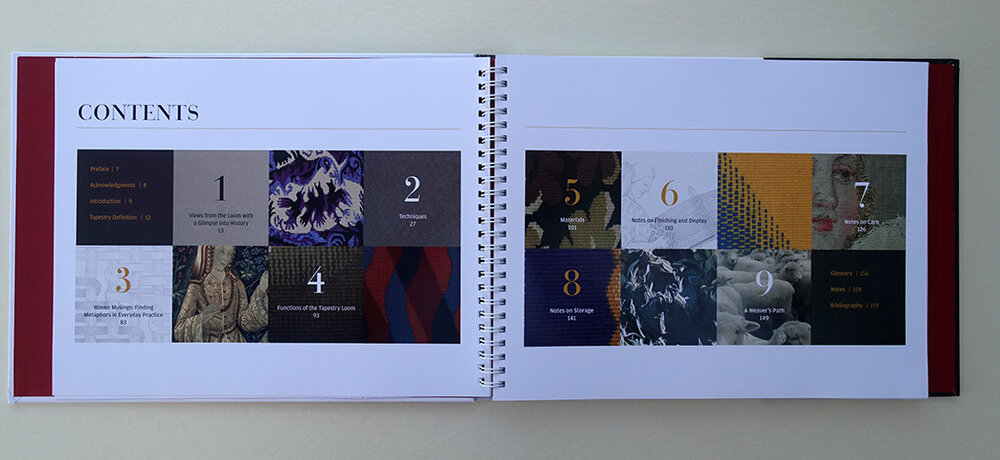
Table of Contents Anatomy of a Tapestry, techniques pages" data-lightbox-theme="dark" href="https://images.squarespace-cdn.com/content/v1/50329a7ec4aa66e8231ce213/1593969452553-8OK3X9ZB0YCG7SWUNVMF/ke17ZwdGBToddI8pDm48kKktH62YepJawavMaMounbsUqsxRUqqbr1mOJYKfIPR7LoDQ9mXPOjoJoqy81S2I8N_N4V1vUb5AoIIIbLZhVYxCRW4BPu10St3TBAUQYVKcxwjyQPSh49jwrvoCUT9sbJAU6Aiz1K3vWAUPpgMXGAcipHLeemgYLDA4uKe8VB2Y/AnatomyofaTapestry3.jpg">
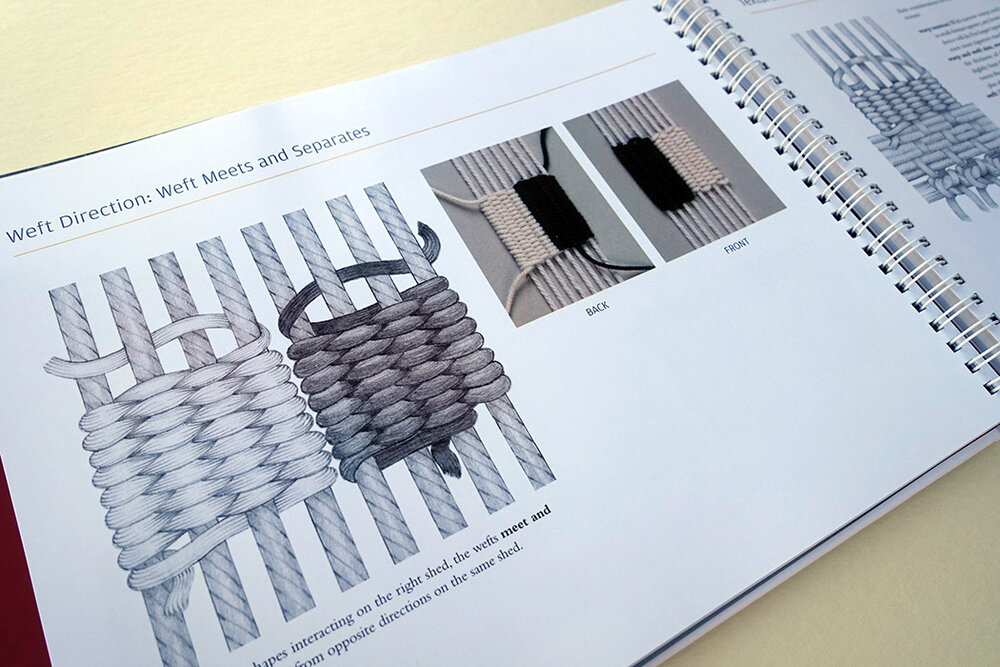
Technique page example Anatomy of a Tapestry" data-lightbox-theme="dark" href="https://images.squarespace-cdn.com/content/v1/50329a7ec4aa66e8231ce213/1593970441193-JA240CIWJTPQHKAP5M5L/ke17ZwdGBToddI8pDm48kKktH62YepJawavMaMounbsUqsxRUqqbr1mOJYKfIPR7LoDQ9mXPOjoJoqy81S2I8N_N4V1vUb5AoIIIbLZhVYxCRW4BPu10St3TBAUQYVKcxwjyQPSh49jwrvoCUT9sbJAU6Aiz1K3vWAUPpgMXGAcipHLeemgYLDA4uKe8VB2Y/AnatomyofaTapestry4.jpg">
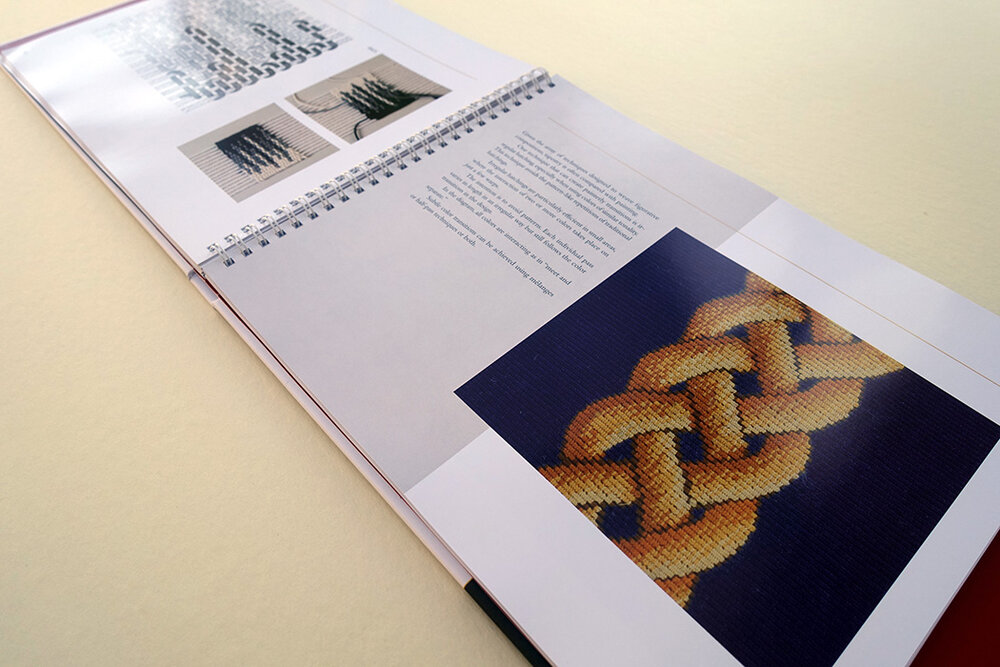
Woven Musings page example Anatomy of a Tapestry" data-lightbox-theme="dark" href="https://images.squarespace-cdn.com/content/v1/50329a7ec4aa66e8231ce213/1593970519900-49UAR477XWZPOI03K7YH/ke17ZwdGBToddI8pDm48kKktH62YepJawavMaMounbsUqsxRUqqbr1mOJYKfIPR7LoDQ9mXPOjoJoqy81S2I8N_N4V1vUb5AoIIIbLZhVYxCRW4BPu10St3TBAUQYVKcxwjyQPSh49jwrvoCUT9sbJAU6Aiz1K3vWAUPpgMXGAcipHLeemgYLDA4uKe8VB2Y/AnatomyofaTapestry5.jpg">
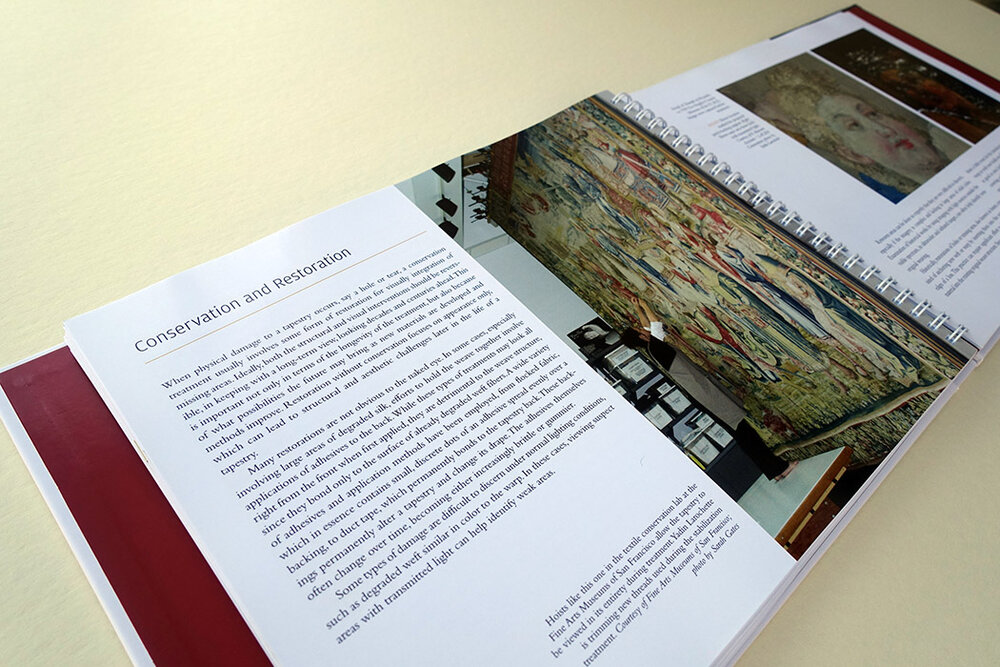
Conservation page example by Jean Pierre Larochette and Yadin Larochette" data-lightbox-theme="dark" href="https://images.squarespace-cdn.com/content/v1/50329a7ec4aa66e8231ce213/1593969457504-EI5694XWAP3NCCHQL1SG/ke17ZwdGBToddI8pDm48kKVLKKc-IVDvSdSWocnI5pcUqsxRUqqbr1mOJYKfIPR7LoDQ9mXPOjoJoqy81S2I8N_N4V1vUb5AoIIIbLZhVYxCRW4BPu10St3TBAUQYVKcdYP9WVEyCGZdCm7RQnAV6rBUWx1Wam9t1gxLEpBfXJTOhOCuxmQ-I1z_vxAutZnh/AnatomyofaTapestry6.jpg">
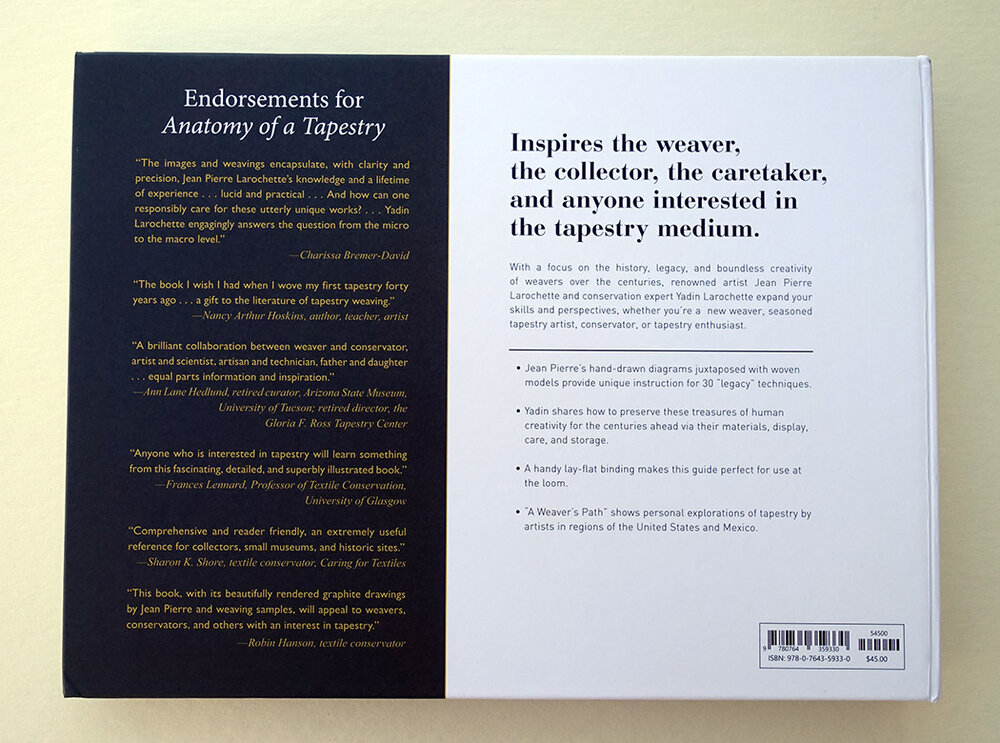
Back cover, Anatomy of a Tapestry
Disclaimer: I was not asked to review this book. I paid full price for my version of the book. This is my honest opinion, but it is only my opinion.